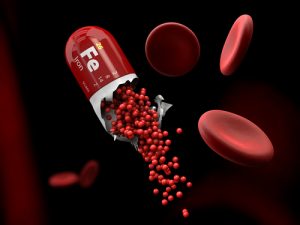Iron levels might play a significant role in determining how you age. Maintaining optimal iron levels might affect your longevity and health. Too much iron in your blood might lead to conditions like Parkinson’s and liver disease while too little can contribute to cognitive decline and increased lethargy. This article is here to help you learn what iron does and how to properly balance your iron levels in order to age as healthily as possible.
How Iron Works
Iron is crucial for blood production in the body. Approximately 70 percent of iron is found in your red blood cells (which is called hemoglobin) and muscle cells (where it is called myoglobin). Hemoglobin transfers blood oxygen from the lungs to the tissues while myoglobin transports, stores and releases oxygen.
Iron benefits the body in many ways. It helps regulate gastrointestinal processes, the brain’s ability to focus, energy levels, the body’s temperature regulation and the immune system. In fact, the entire human body depends on having a sufficient iron level.
Optimal Iron Levels
Doctors often use the word “normal” to describe iron levels, but the truth is that iron levels need to be optimal. Most lab tests for iron look only at how much iron you have in your blood for immediate use. They do not always look at your stored iron (referred to as ferritin), which can indicate whether you might have iron-deficiency anemia.
Optimal iron levels are within a saturation range of 20 to 50 percent. The optimal range for ferritin is 50 nanograms per milliliter to 150 nanograms per milliliter. A number of factors can cause low iron levels (under 20 percent). Low ferritin is typically indicative of iron deficiency anemia. Too much is also a cause for concern.
 Iron Supplements
Iron Supplements
Human beings predominantly get iron from their diet, but that might not be enough for some people. Taking iron supplements can help boost iron levels. For those who are getting older, this might be helpful since iron deficiency anemia becomes more likely the older you get. In fact, about 10 percent of Americans over the age of 65 have iron deficiency anemia.
This can happen due to all kinds of conditions, ranging from inflammatory bowel disease to ulcers. Internal bleeding is sometimes a culprit and needs to be stopped as quickly as possible. A black, tar-like stool is typically a good indicator of an internal bleeding issue. Sometimes, the bleeding will resolve itself, but other times, it might not. Getting your iron levels up to optimal can help when internal bleeding is the cause.
Naturally Boosting Your Iron Levels
Per USDA recommendations, adults should get about eight milligrams of iron in their diets every day. Iron can be found in foods like fish, poultry and red meat. It is also prevalent in beans and legumes. Leafy greens and whole grains also provide ample amounts of iron, and vegans and vegetarians will need to eat more of these to compensate.
Levels of iron can also be boosted by eating a lot of vitamin C-rich foods since they increase the absorption of none-heme iron. You will also need to consider avoiding certain foods if you have iron deficiency anemia, including dairy products and gluten.
Be sure to consult with your doctor if you suspect that your iron level might be off. Bear in mind that levels do fluctuate on their own (even over the course of the day), but tests can show if yours are too high or low. Aging does not mean having to accept poor iron levels; with a proper diet and/or supplements, you can balance your iron back into the optimal range.

 Iron Supplements
Iron Supplements



